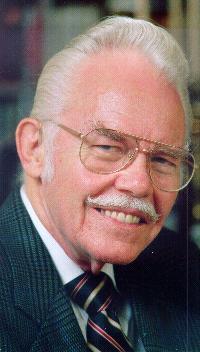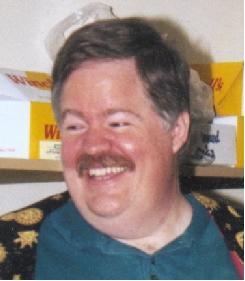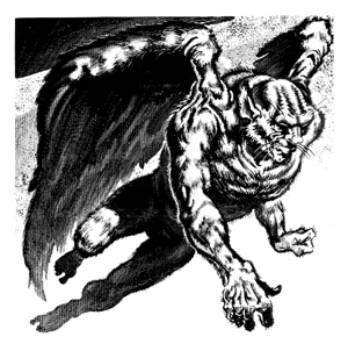


George R.R. Martin was born September 20, 1948 in Bayonne, New Jersey.
His father was Raymond Collins Martin, a longshoreman, and his mother was Margaret Brady
Martin. He has two sisters, Darleen Martin Lapinski and Janet Martin Patten.
Martin attended Mary Jane Donohoe School and Marist High School. He began writing very young, selling monster stories to other neighborhood children for pennies, dramatic readings included. Later he became a comic book fan and collector in high school, and began to write fiction for comic fanzines (amateur fan magazines). Martin's first professional sale was made in 1970 at age 21: "The Hero," sold to Galaxy, published in February, 1971 issue. Other sales followed.
In 1970 Martin received a B.S. in Journalism from Northwestern University, Evanston, Illinois, graduating summa cum laude. He went on to complete a M.S. in Journalism in 1971, also from Northwestern.
As a conscientious objector, Martin did alternative service 1972-1974 with VISTA, attached to Cook County Legal Assistance Foundation. He also directed chess tournaments for the Continental Chess Association from 1973-1976, and was a Journalism instructor at Clarke College, Dubuque, Iowa, from 1976-1978. He wrote part-time throughout the 1970s while working as a VISTA Volunteer, chess director, and teacher. In 1975 he married Gale Burnick. They divorced in 1979, with no children. Martin became a full-time writer in 1979. He was writer-in-residence at Clarke College from 1978-79.
Moving on to Hollywood, Martin signed on as a story editor for Twilight Zone at CBS Television in 1986.
In 1987 Martin became an Executive Story Consultant for Beauty and the Beast at CBS. In 1988 he became a Producer for Beauty and the Beast, then in 1989 moved up to Co-Supervising Producer. He was Executive Producer for Doorways, a pilot which he wrote for Columbia Pictures Television, which was filmed during 1992-93.
Martin's present home is Santa Fe, New Mexico. He is a member of Science Fiction & Fantasy Writers of America (he was South-Central Regional Director 1977-1979, and Vice President 1996-1998), and of Writers' Guild of America, West.
Web Site: www.georgerrmartin.com
 Frank
Kelly Freas
Frank
Kelly FreasFrank Kelly Freas is universally recognized as one of the
most prolific and popular science fiction and fantasy artists in the world. His
distinguished career spans fifty years from painting covers for Astounding Science Fiction
and Planet Stories in the 1950's, to visualizing the most current concepts in science
fiction illustration, gaming, and motion picture concepts, as evidenced by his winning the
readers' poll award from Analog Magazine for Best Cover of the Year in 1991, two Chesley
Awards [1990 and 1997] and the Writers of the Future Lifetime Achievement Award in 1999.
In 2000 Freas was elected a Fellow of the International Association of Astronomical
Artists.
Over the years, Freas' art has graced the covers of hundreds of science fiction books and
magazines, including works by Poul Anderson, Isaac Asimov, Arthur C. Clarke, Robert
Heinlein, Dean R. Koontz, Ursula K. LeGuin, Frederik Pohl, A.E. Van Vogt, etc. He also
contributed covers to MAD Magazine from 1955 to 1962, as well as numerous other commercial
illustrations, such as the record jacket for Queen's best-selling album, News of the
world, and the cover of the 1992 Star Trek Annual for DC Comics. An official NASA artist,
Freas' space posters hang in the Smithsonian Museum in Washington. He was also
commissioned by the Skylab I astronauts to design their crew patch.
Dubbed the "most popular sf artist in the history of the field" by the respected
Encyclopedia of Science Fiction, Freas is the first artist to have won ten Hugo Awards,
the highest recognition granted to a science fiction artist, having been nominated an
all-time record of twenty times. He has also won numerous other genre awards, including
the NATTS's Hall of Fame in 1991. In 1994, Starlog Magazine included him in their
prestigious list of The 200 Most Important People in Science Fiction and Fantasy.
Freas' original paintings hang in museums, universities, and private collections. His work
has been the subject of three best-selling collections: The Astounding Fifties, Frank
Kelly Freas: The Art of Science Fiction, and Frank Kelly Freas: A Separate Star. No other
artist in science fiction has consistently matched his astounding record. His smooth and
luminous images, amiable aliens and sexy women, have become part of today's science
fiction landscape.
Web Site: www.KellyFreas.com

Mike Glyer has been in fandom for years. His list of impressive
accomplishments include working on local conventions and Worldcon bids, conventions,
as he is a past Worldcon Chair himself. His is also editor of the Hugo winning
publication, File 770
Web Site: ourworld.compuserve.com/homepages/mglyer
 Spider
Robinson
Spider
RobinsonSince he began writing professionally in 1972, Spider
Robinson has won 3 Hugo Awards, a Nebula Award, the John W. Campbell Award for Best New
Writer, the E.E. ("Doc") Smith Memorial Award (Skylark), the Pat Terry Memorial
Award for Humorous Science Fiction, and Locus Awards for Best Novella and Best Critic.
Twenty-four of his 30 books are still in print, in 10 languages. His short work has
appeared in magazines around the planet, from Omni and Analog to Xhurnal
Izobretatel i Rationalizator (Moscow), and in numerous anthologies.
His most recent publications are the novel CALLAHAN'S CON (Tor hc July 03),
two collections, GOD IS AN IRON AND OTHER STORIES (Five Star/Tekno trade pb
May 02) and BY ANY OTHER NAME (Baen pb Fe 01) , and the non-Callahan novel
THE FREE LUNCH (Tor hc/pb Au01/02).
A CD-ROM computer game, "Callahan's Crosstime Saloon," adapted by Josh Mandel,
was released in 1997 by Legend Entertainment/ Take Two, featuring original music performed
by Spider with legendary guitarist Amos Garrett. The Usenet newsgroup alt.callahans,
inspired by the Callahan series, was rated the 151st largest newsgroup by bits posted,
172nd by messages posted (placing it in the top 1%), and propagates to over 60% of all
Usenet sites.
Spider was born in New York City on 3 successive days (they had to handle him in
sections), and holds a Bachelors degree in English from the State University of New York.
In 1992 he was the Toastmaster for the 50th World SF Convention in Orlando. He was book
reviewer for Galaxy, Analog and New Destinies magazines for nearly a
decade, and currently writes occasional book reviews and a regular Op-Ed column,
"Future Tense," for The Globe and Mail, Canada's national newspaper. In
addition his column "Nocturnal Emissions" has been running biweekly since
January 2000 on the Galaxy Online website.
He has been married for 25 years to Jeanne Robinson, a Boston-born writer, modern dance
choreographer, former dancer, and teacher of dance and the Alexander Techniquw; she was
Artistic Director of Halifax's Nova Dance Theatre during its 8-year history. The Robinsons
collaborated on the Hugo-, Nebula- and Locus-winning 1976 classic novel STARDANCE [Baen
Books pb, Dec 91; Easton Press leatherbound 92], which created the concept of zero-gravity
dance, and on its sequels, STARSEED [Ace hc and pb, Oct 91/92, Easton Press leather 91]
and STARMIND [Ace hc and pb, Easton leather, June 95/Feb 96.] (Jeanne was on NASA's short
list for a Space Shuttle seat, to try out zero-gee dance in practice -- until the Challenger
Tragedy ended the Civilian In Space programme.) Their first two books were reissued
together in one volume as THE STAR DANCERS by Baen Books in September 97. The final
volume, STARMIND, will also be reissued by Baen, in 2001.
Spider and Jeanne met in the woods of Nova Scotia in the early 1970s, and have lived for
the last 12 years in British Columbia, where they raise and exhibit hopes. Their daughter
Terri graduated from Simon Fraser University and is now print production coordinator for
Martha Stewart Living Magazine in New York.
Web Site: www.SpiderRobinson.com
by Mike
Glicksohn
I first-encountered science fiction in
the early 1950s, on BBC radio and in the odd-sized pulp pages of the combination
comic-strip/prose-tale British comics of the era. I became a lifetime addict. A little
more than a decade later I discovered Science Fiction Fandom (at the Cleveland Worldcon in
1966) and it became a major part of my life for the next thirty five years.
In the course
of my (occasionally high-profile) interaction with fandom, I’ve had the opportunity
to meet/become acquainted with/become friends with most of the science fiction writers
from Asimov to Zelazny. A (delightfully) few of these “legends” have had
enormous clay feet but the vast majority turned out to be just what you’d expect:
decent people who just happened to have a talent that made them heroes in my younger eyes.
But a handful
turned out to actually be the larger-than-life giants my teenage self imagined them to be.
And the noblest gentleman of them all was undoubtedly Robert Bloch.
When I became
a “science fiction fan” I was attracted to the world of fanzines and devoted
much of my time and energy to writing for and eventually publishing them. And it
didn’t take me long to realize that Robert Bloch, internationally-famous author of
“Pyscho” and hundreds of award-winning horror, mystery and science fiction tales
had been and still was a fanzine fan. So when I started my own fanzine, naturally I sent
him a copy (it wasn’t hard to find his address as his letters frequently appeared in
some of the ‘zines I’d collected.)
 And he responded! With
a postcard and some complimentary remarks about my undoubtedly amateurish efforts. The
effect on this young fan was electrifying. Robert Bloch had read and replied to my
magazine! Robert Bloch!!
And he responded! With
a postcard and some complimentary remarks about my undoubtedly amateurish efforts. The
effect on this young fan was electrifying. Robert Bloch had read and replied to my
magazine! Robert Bloch!!
Yet I’m
probably one of hundreds of fanzine publishers who have experienced that rush at getting a
postcard-of-comment from this legendary author. For all his fame, for all his notoriety,
Bloch never forgot his roots as a fanzine fan and over the course of his lifetime must
have sent many hundreds of hand-written postcards thanking other fans for sending him
their publications. Many authors have seemed to feel they owe a debt to fandom but I know
of no-one who gave as much or as unselfishly as Robert Bloch. And it’s this
whole-hearted dedication to fandom, the microcosm which helped him establish his career,
which has always made me think Robert Bloch is the quintessentially fannish science
fiction superstar, the “spirit” of what makes science fiction fandom a very
special place to be.
Bloch was the
Guest of Honour at TORCON in 1948, of course. (I was two years old and in England at the
time so I couldn’t be there.) A quarter-century later he became one of the rare
repeat Guests of Honour at TORCON 2 in 1973. And we met in person for the first time (I
was helping run the convention.) By then my fanzine was in the running for a Hugo and
I’d sent him each issue as it was published (always getting back a hard-to-decipher
hand-written postcard which revealed that the issue had been read.)
Robert Bloch
welcomed me as an old friend. He commented on things in my most recent issue (which had
been published some four months before the convention), greeted me as a fellow member of
the fellowship of fanzine fans and quite simply impressed the hell out of me. I
thought then as I continue to think now: nobody embodies the true spirit of science
fiction fandom better than Robert Bloch.
Over the
succeeding decades I had the pleasure of meeting Bloch in person several times but I
continued to send him my fanzines and he continued to reply with postcards. In 1982, at a
convention somewhere, I asked him to autograph a copy of “The Eighth Stage of
Fandom”, a 1962 collection of articles that he’d written for fanzines over the
years. His over-stated but flattering inscription read, “For Mike, who has elevated
fandom far beyond the eighth stage, with admiration and affection, Robert Bloch.”
Just another example of what a true gentleman he was.
When his
autobiography appeared in 1993 I immediately bought a copy, read and enjoyed it (while
being saddened at how often fate had dealt him a rotten hand) and I wrote and asked him if
he’d sign my copy of the book if I mailed it to him (with return postage, of course.)
When I got back a wonderful letter from him saying he’d be happy to oblige an old
friend (a letter I’ve kept to this day) I shipped the book to California and since I
knew he was ill (although not just how ill he was) I took the time to do something
I’ve rarely done: I wrote a fan letter to an author I considered a friend and told
him just how much his writing and our contacts had meant to me. I’ll always be glad I
did that.
Bob sent the
book back quickly with a delightful inscription, reinforcing my belief that he was one
hell of a good man.
And a
relatively short time later Robert Bloch died.
I wept. And I
wondered at the fact that despite all of his personal problems this incredible fan had
taken the time to exchange letters with me and to sign and mail me back my copy of his
book.
Some amazing
people have been a part of science fiction fandom and have given back to it more than
could ever be expected. None more so than Robert Bloch. This brilliant writer and
consummate punster epitomizes the best that science fiction fandom has to offer.
Had he lived
until 2003, Robert Bloch would have been an honoured Guest of TORCON 3. As it is, we
recognize that few writers have ever embodied the sense of family and belonging that is
the essence of science fiction fandom better than he did and in a very real sense Robert
Bloch exemplifies the “spirit” of fandom more than anyone else I know.
It is for
that reason I conceived the idea of having him as TORCON 3's “GoHst of Honour.”
(In case anybody missed it, a convention “Guest of Honour” is traditionally
referred to as “the GoH”, pronounced “go”, hence “GoHst”,
which is pronounced “ghost”.)
I like to
think Bob would have appreciated both the gesture and the double pun.
Last updated: 15 July 2003 by Drew Mathers.
Send comments or suggestions to website@torcon3.on.ca
.